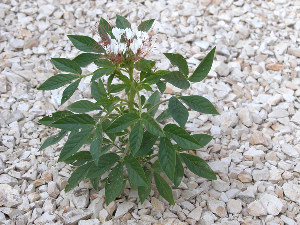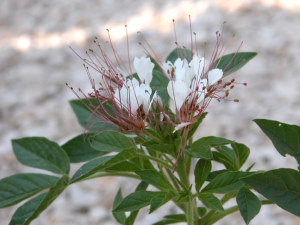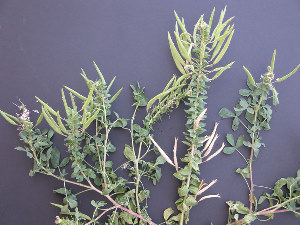Clammyweed
Polanisia dodecandra (L.) DC. ssp.
trachysperma (Torrey & A. Gray)
Iltis
Capparaceae or Capparidaceae (Caper Family)
Clammyweed is an upright herb completely covered with translucent hairs that are tipped with glands exuding a sticky-moist substance. Native groups in the Southwest used similar species as a minor food resource and for healing purposes.
Although described as an annual that is rarely a perennial (Correll and Johnston 1970), clammyweed apparently overwinters well in this area. The vegetative part of the plant has an unpleasant odor. The numerous flowers have white petals about 3/4 inch long that are narrow at the base and spreading at the tip. The stamens are reddish-purple and extend beyond the petals, giving the white flower an attractive purple fringe. The fruit is a capsule that measures about 1/2 inch wide and 2-3 inches long. In contrast to the leaves and stems, the flowers have a very sweet scent. The leaf consists of three palmately arranged leaflets, each leaflet measuring up to 1 and 3/4 inches in length.
Archeological occurrence. Both beeweed and clammyweed produce a black, ovate seed that measures 2 mm diameter and has a curved embryo with a beak. The seed-type (clammyweed/beeweed) has been recorded from several archeological sites across the greater Southwest (Adams 1980). At Hinds Cave, the clammyweed/beeweed seed type has been recorded from Area F, dated to 1280 B.P.
Food, healing and ritual.The ethnographic accounts of this plant are combined with the rocky mountain bee plant, Cleome serrulata, another member of the Capparaceae. According to Matilda Coxe Stevenson (Stevenson 1915:69), the Zuni gave clammyweed the same name as rocky mountain bee plant but it is not clear whether the two plants have the same use. Castetter (1935:24) maintained that the two plants were used in similar fashion. Adams (1980) also considers the possibility that the plants were used in a similar fashion. This author has boiled and eaten clammyweed in a manner described for beeweed. The Zuni boiled the young, tender leaves of beeweed, and perhaps clammyweed, with corn and they gathered the leaves and dried them for use during the winter. The Hopi boiled the plants with green corn, and the Hano boiled them and ate them with corn meal porridge (Castetter 1935:24).
The Tewa ground the whole plant and mixed it with water for a drink that was taken internally for stomach problems. The fresh plant was wrapped in a cloth and placed on the abdomen (Robbins et al. 1916). Chewed root and blossoms of clammyweed were chewed and applied to the bodies in a Cactus fraternity ceremony (Stevenson 1915:96).
References:
Adams, Karen R.
1980 Pollen, Parched Seeds and Prehistory: A Pilot Investigation of Prehistoric Plant Remains from Salmon Ruin, a Chacoan Pueblo in Northwestern New Mexico. Contributions in Anthropology 9. Eastern New Mexico University, Portales, New Mexico.
Castetter, Edward F.
1935 Uncultivated Native Plants Used as Sources of Food. Ethnobiological Studies in the American Southwest. Vol. I. The University of New Mexico Bulletin, Biological Series 4(1). Albuquerque, New Mexico.
Correll, Donovan S. and Marshall C. Johnston
1970 Manual of the Vascular Plants of Texas. Contributions from the Texas Research Foundation, Volume 6. Renner, Texas.
Robbins, Wilfred Wiliam, John Peabody Harrington, and Barbara Freire-Marreco
1916 Ethnobotany of the Tewa Indians. Bureau of American Ethnology Bulletin 55. Smithsonian Institution. Washington, D.C.
Stevenson, Matilda Coxe
1915 Ethnobotany of the Zuni Indians. In Thirtieth Annual Report of the Bureau of American Ethnology, [1908-1909], pp. 35-103. Washington, D.C.
![]()


